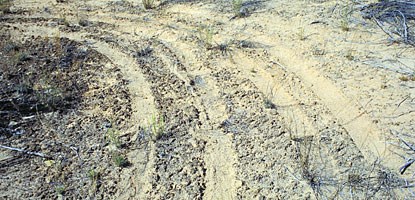
Though much of Canyonlands remains undeveloped, its lands are not necessarily undisturbed. Much of the area is covered by biological soil crust, a living crust found throughout the world that plays an important role in the ecosystems in which it occurs. Unfortunately, many human activities negatively affect the presence and health of biological soil crusts. Compressional stresses placed on them by footprints or machinery are extremely harmful, especially when the crusts are dry and brittle. Tracks in continuous strips, like those produced by vehicles or bicycles, create areas that are highly vulnerable to wind and water erosion. Rainfall carries away loose material, often creating channels along these tracks, especially on slopes. Wind not only blows pieces of the pulverized crust away, thereby preventing reattachment to disturbed areas, but also disrupts the underlying loose soil, often covering nearby crusts. Since crustal organisms need light to photosynthesize, burial can mean death. When large sandy areas are impacted during dry periods, previously stable areas can become a series of shifting sand dunes in just a few years. Air pollutants, both from urban areas and coal-fired power plants, also adversely affect the physiology of these crusts. A great deal of research about biological soil crust has been conducted at Canyonlands. Soil health and chemistry are measured at transects throughout the park. Certain relict areas, where human impacts (including livestock grazing) have been minimal or nonexistent, are closed to entry and provide crucial control areas to which disturbed areas can be compared. |
Last updated: February 2, 2018
